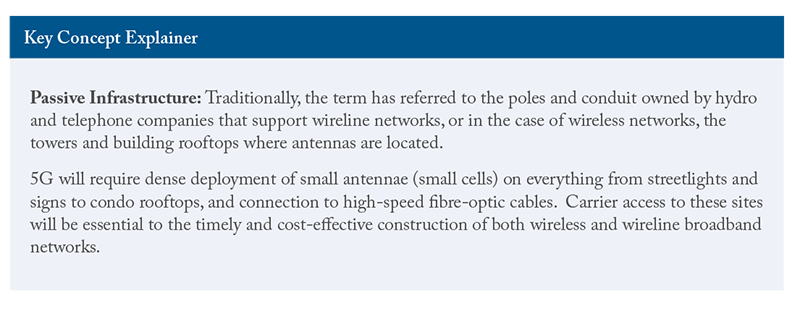The Study In Brief
Next-generation broadband networks are poised to be key enablers of Canada’s future economic and social prosperity. 5G alone is expected to be transformative, generating billions in additional gross domestic product, thousands of jobs, and myriad social benefits.
Expedient deployment of these networks and realization of the economic and social benefits they will produce depend on timely and reasonable access to the infrastructure that supports wireline and wireless network facilities and the land on which these supporting structures and facilities are placed; that is, “passive infrastructure.”
Other countries, such as the United States and the United Kingdom, have made material changes in recent years to their regulatory frameworks for carrier access to passive infrastructure to support the deployment of next-generation communications networks. In contrast, Canada’s regulatory framework for carrier access to passive infrastructure remains largely unchanged from the regime that was established to support construction of monopoly telegraph and telephone infrastructure. Not surprisingly, this regime focuses on the construction of “transmission lines.” A regime that does not expressly capture wireless infrastructure is plainly inadequate at this juncture. More generally, the current regulatory framework fails to establish comprehensive and consistent regulatory oversight over carrier access to provincial and municipal supporting infrastructure and land to construct and maintain their wireline and wireless facilities or provide for the effective resolution of access disputes.
This paper makes seven recommendations to modernize and streamline the framework for carrier access to passive infrastructure in Canada. Most of these recommendations propose amendments to the Telecommunications Act to clarify that the Canadian Radio-television and Telecommunications Commission has explicit authority to address access issues involving both wireline and wireless facilities, on all forms of support structures and on all lands.
These recommendations, if implemented, would eliminate many of the obstacles carriers face when expanding their networks, and facilitate timely and cost-effective construction of the communications system that will power Canada’s post-pandemic recovery and economic and social prosperity in the
digital economy.
Introduction
Next-generation wireline and wireless broadband networks are poised to be key enablers of Canadian economic growth, social inclusion and the post-pandemic recovery.
These networks are expected to drive Canadian productivity and innovation; provide a platform for global commercial activity; enable delivery of education, health and other social services; support the reduction of Canada’s carbon footprint; and foster social and cultural connections.
5G alone – the new global standard for wireless networks – is likely to be transformative. In combination with advances in artificial intelligence (AI), the Internet-of-Things (IoT) and quantum computing, the increased speed, reliability, security, capacity and reduced latency of 5G should enable the following: enhanced productivity; improved delivery of healthcare, education, public transportation and other public services; reduced environmental impact, including carbon emissions; and affordable rural broadband connectivity. It is estimated that 5G will add nearly $40 billion to Canada’s gross domestic product (GDP) by 2025, create 250,000 permanent jobs and significantly improve the quality of Canadians’ lives.
Wireline networks are integral to the transport of 5G services. Wireline networks also need to be expanded and upgraded to satisfy the continued explosive growth in Canadians’ demand for data and to implement the network technologies and innovations required to support high-quality broadband access across Canada at affordable rates.
A critical input to the effective and efficient deployment and expansion of these next-generation telecommunications networks is timely access, on reasonable terms and conditions, to the “passive infrastructure” that supports wireline and wireless telecommunications network facilities and the land on which these structures and facilities are deployed.
Wireline networks are largely supported by poles and underground conduit owned by the telephone and electric utility companies, often located along roadways and other rights-of-way. Antennae for wireless networks traditionally have been supported by large macro towers and building rooftops. Although 5G will continue to use this traditional passive infrastructure, the next-generation functionality of 5G – carriage of massive amounts of data at extremely high speeds – will require the dense deployment of small antennae or “small cells” on non-traditional supporting infrastructure, including buildings and all manner of street furniture such as streetlights, signs and bus shelters, as well as telephone and electric utility poles. Each supporting structure must also be connected to fibre-optic cables in order to transport data at lightning speed, with ultra-low latency and ultra-high reliability.

The current regime for carrier access to passive infrastructure is largely modelled on provisions in the Railway Act, the predecessor to the 1993 Telecommunications Act. The regime, which was established in the time of monopoly provision of telegraph and telephone services, is in serious need of amendment to support timely and cost-effective construction of wireless and wireline broadband networks. Key shortcomings in the current regime include:
- no federal oversight over the terms and conditions of access to highways or other public places to deploy wireless infrastructure, according to a recent decision of the Canadian Radio-television and Telecommunications Commission (the “CRTC”);
- no comprehensive and consistent regulatory oversight over publicly owned supporting infrastructure; at best, there is patchwork provincial oversight over access to electric utility supporting infrastructure by regulators with no specific mandate to consider Canadian telecommunications policy objectives;
- no clear regulatory oversight over carrier access to multi-tenant buildings and to land being developed for multi-tenant residential or commercial occupancy; and
- no access without consent, with recourse to lengthy and uncertain case-by-case dispute resolution if regulatory oversight exists.
The absence of an effective federal regulatory framework for carrier access to passive infrastructure is a material barrier to the construction of next-generation telecommunications infrastructure in Canada. Carriers are in many instances at the mercy of public authorities and other property owners and developers with respect to access terms and face extended construction delays and the choice between accepting unreasonable access terms and higher costs, lengthy and uncertain dispute resolution, less efficient deployment routes (if available) or forgoing deployment altogether.
All of these shortcomings have serious negative ramifications for Canada’s economic and social well-being. Specifically, they cause:
- regulatory uncertainty, resulting in reduced broadband investment;
- delayed deployment of broadband networks, including 5G and rural deployment;
- increased costs of deployment of broadband networks, resulting in reduced investment in this infrastructure and higher broadband prices; and
- reduced spillover effects from telecommunications investment on economic growth and social inclusion and prosperity.
Other countries have taken steps to modernize their frameworks to facilitate the expedient rollout of 5G and wireline broadband. Canada is behind, hamstrung by a legislative framework developed more than 50 years ago – well before the requirement for ubiquitous broadband and wireless services had been conceived.
The following recommendations are directed at modernizing Canada’s regulatory framework for carrier access to passive infrastructure:
Recommendation 1: Amend the Telecommunications Act to make it explicit that carriers’ “qualified right of access” – that is, the right of carriers under the Act to access rights-of-way and other places for the construction, operation and maintenance of a transmission line – and the jurisdiction of the CRTC over such access encompass both wireline and wireless transmission facilities.
Recommendation 2: Amend the Telecommunications Act to make it explicit that carriers’ qualified right of access and the CRTC’s jurisdiction over such access encompass all publicly owned land and railway rights-of-way, bridges and crossings.
Recommendation 3: Amend the Telecommunications Act to make it explicit that the CRTC has jurisdiction to establish terms and conditions of carrier access to all publicly owned structures capable of supporting wireline and wireless transmission facilities, including municipal street furniture, as well as poles and conduit owned by provincial and municipal electric utilities and other utilities.
Recommendation 4: Amend the Telecommunications Act to give the CRTC authority to establish generally applicable baseline standards for carrier access to rights-of-way, public places, and supporting infrastructure under its jurisdiction and to permit interested parties to seek a waiver of the standard terms on a case-by-case basis.
Recommendation 5: Amend the Telecommunications Act to give the CRTC explicit authority to establish baseline federal standards for carrier access to multi-tenant buildings and to land under development for multi-tenant residential or commercial use that apply in the absence of substantially similar provincial regulation.
Recommendation 6: Amend the Telecommunications Act to oblige the CRTC and parties to conduct dispute resolution proceedings quickly and efficiently in order to avoid delays and added expenses in obtaining approvals to build new facilities.
Recommendation 7: Consult on amendments to Innovation, Science and Economic Development Canada’s antenna-siting procedures to address small cell deployment and delays in antenna siting.
Implementation of these recommendations will facilitate the achievement of core Canadian policy objectives – including closing the digital divide and enhancing Canada’s economic growth and prosperity and social inclusion. This is because delays and unreasonable terms of access to passive infrastructure jeopardize Canada’s deployment of next-generation networks and the economic and social benefits these networks are expected to enable.
Carrier Access to Passive Infrastructure under the Telecommunications Act
The Telecommunications Act (the “Act”) is the federal legislation that regulates the provision of telecommunications services and telecommunications carriers in Canada. The Act’s provisions concerning access to rights-of-way and public places and supporting infrastructure – that is, passive infrastructure – are largely a “cut and paste” from those in the former Railway Act. These provisions give a carrier the right “to enter on and break up any highway or other public place for the purpose of constructing, maintaining or operating its transmission lines and may remain there as long as necessary for that purpose, but shall not unduly interfere with the public use or enjoyment of the highway or other public place.”
A companion provision of the Telecommunications Act provides that a municipality or other public authority may apply to the CRTC for an order directing a carrier to bury or alter the route of a transmission line, subject to any conditions determined by the CRTC, and to prohibit the construction, operation or maintenance of a transmission line except as directed by the CRTC.
The Act also confers on the CRTC what appears to be a broad authority to address access to supporting structures.
Key elements of this framework are discussed below.
Meaning of “Transmission Line”
The term “transmission line” is not defined in the Telecommunications Act. Municipalities and other public authorities have taken the position that a wireless facility is not a “transmission line” and as a result is not covered by the qualified right of access established by the Act. Moreover, in a recent proceeding, the CRTC concluded that “transmission line” means wires and cables, and therefore does not include wireless transmission facilities.
Meaning of “Highways and Other Public Places”
The qualified right of access applies to “highways and other public places.” In a 2005 decision, the CRTC held that light rail transit (“LRT”) tunnels did not qualify as such a “highway,” which “must be a public road or way equally open to everyone for travel … in their own motor vehicles.”
This guidance is helpful, but there remains considerable uncertainty over when a location qualifies as an “other public place.” It is not clear, for example, if public buildings qualify, and the CRTC has declined to clarify this issue in light of its determination that wireless facilities are not “transmission lines.”
Access to Land under Development and to Multi-tenant Properties
Although both the CRTC and the courts have signalled that carriers’ qualified right of access to passive infrastructure under the Telecommunications Act is limited to publicly owned highways and other public places,
In 1998, for example, the CRTC was asked to order a developer, Metrus, to allow Bell and Shaw to access its subdivision development during the construction phase for the deployment of their transmission lines, as the developer would grant access only to its affiliated carrier, Futureway. The CRTC refused to order access, holding that Bell and Shaw could seek access to roads in the development following transfer of these lands to the municipality, or seek to resell Futureway’s local access facilities. Construction of transmission lines after roads have been paved and turned over to a municipality is slower, more costly and more disruptive to the public.
In the case of multi-tenant buildings, the CRTC has identified guidelines for reasonable terms of access, but these guidelines are not binding and the CRTC has never directly ordered a building owner to provide access. Rather, the CRTC has prohibited carriers from entering into exclusive and preferred building-access agreements and established escalating limits on the provision of service to tenants by carriers that have obtained access when another carrier has been denied access.
Access to Railway Rights-of-Way
Railway rights-of-way and bridges are, like highways, an effective location for wireline telecommunications facilities. In addition, wireline facilities frequently must transit railway crossings. At present, the CRTC has no jurisdiction to adjudicate disputes regarding terms of access by carriers to railway rights-of-way, bridges or crossings. The Canadian Transportation Agency may adjudicate disputes relating to costs incurred by carriers for transmission facilities placed on, under or over railway crossings of federal and some provincial railways, and has provided helpful precedents on the appropriate allocation of these costs, but its jurisdiction is limited.
Consent-based Access and Case-by-Case Dispute Resolution
The Telecommunications Act provides for consent-based access with recourse to case-by-case dispute resolution. Carriers must obtain consent from the relevant public authority before constructing transmission lines, which typically requires negotiation of access terms. If agreement on reasonable terms cannot be reached, one or both parties can request the CRTC to adjudicate the access terms.
Since 2001, the CRTC has addressed a number of such disputes, and although the resulting decisions offer useful guidance on the CRTC’s approach to access terms, each decision is binding only in respect of the specific dispute or agreement in question.
The time the CRTC has taken to render a decision on these disputes has often been well in excess of two years. This does not include the negotiations that precede the filing of an application with the CRTC. Multiple construction seasons can be lost during negotiation and dispute resolution of access terms. While a carrier might be able to continue to construct facilities during the dispute resolution process, the prolonged period of uncertainty over access terms has a negative impact on deployment.
Access to Supporting Structures
The CRTC regulates the rates and terms of access to certain supporting structures owned by telephone companies under its general tariff and other authority over carriers.
In addition to its general regulatory authority over carriers, subsection 43(5) of the Telecommunications Act – on its face – confers broad authority on the CRTC to address carrier access to supporting infrastructure located on highways and other public places. This provision states: “Where a person who provides services to the public cannot, on terms acceptable to that person, gain access to the supporting structure of a transmission line constructed on a highway or other public place, that person may apply to the Commission for a right of access to the supporting structure for the purpose of providing such services and the Commission may grant the permission subject to any conditions that the Commission determines.” Despite its broad terms, the courts have held that this provision does not cover poles owned by electricity distribution companies.
As indicated above, the CRTC also recently declined to consider whether public buildings – which are important supporting infrastructure for 5G small cells and associated wireline facilities – qualify as an “other public place,” given its determination that wireless transmission facilities are not “transmission lines.”
Carrier Access to Passive Infrastructure under the Radiocommunications Act
Under the Radiocommunications Act, the Minister of Innovation, Science and Industry may issue authorizations for radio apparatus and the use of radio frequencies, set the terms and conditions of these authorizations, and “approve each site on which radio apparatus, including antenna systems, may be located, and approve the erection of all masts, towers and other antenna-supporting structures.”
ISED’s antenna siting procedures identify the procedures that must be followed by wireless carriers to obtain approval for an antenna site.
The courts have held that municipalities do not have authority to dictate the location and operation of telecommunications facilities by carriers.
Rogers began looking for a site to address a gap in its wireless coverage in Châteauguay, Quebec, in fall 2007 and entered into a lease with a property owner for the placement of a new wireless tower in December. In March 2008, Rogers notified the city of its intention to build a tower at the site. The city opposed the project but, following consultation and discussions with Rogers on mitigation measures, issued a building permit for construction of the tower in February 2009 – almost a year after the city had first been notified of the project. However, before Rogers could commence construction, Châteauguay requested that the land-use consultation process be reopened. The initial building permit expired. A second land-use consultation was concluded with no agreement by the city to reissue a building permit for the tower. In September 2009, the Minister of Innovation, Science and Industry determined that the period for the second consultation process had expired, but the city continued to refuse to reissue a building permit. In October 2010, the city passed a “Notice of Reserve” barring construction of the antenna at the site. The matter was litigated to the Supreme Court of Canada, which ultimately determined in October 2016 that Châteauguay’s prohibition on construction of the antenna was unconstitutional – almost nine years after Rogers had first identified the site.
While this case might be an extreme example, carriers routinely face lengthy delays in gaining local approval for wireless antenna sites. Carriers can seek a determination from ISED that its siting procedures have been satisfied and a site approved, but there are no established timelines for an ISED decision, no binding cap on the time for local site approval, and no remedy for delayed local approval.
It is also important to underscore that there is no qualified right of access – even to highways or other public places – under the Radiocommunication Act. The minister’s authority is limited to approval or disapproval of an antenna location. The minister has no authority to adjudicate rates and other terms under which a public or private landowner grants access to its land for the placement of a wireless antenna and supporting infrastructure. The minister’s authority over access to supporting infrastructure for wireless facilities is also limited to conditions in the licences held by wireless carriers. The minister has no authority under the Act to regulate unlicensed landlords, including public land owners, or access to publicly owned supporting infrastructure.
Provincial Regulation of Access to Supporting Structures of Electric Utilities
As a result of the Barrie Decision, the CRTC does not have authority to address the terms under which carriers can obtain access to poles and other supporting infrastructure of electric utilities. Duplication of this infrastructure by carriers is not in the public interest. Moreover, even if public approval to over-build a pole line could be obtained, the construction of duplicate pole lines is slow, disruptive, and inefficient.
In the absence of federal oversight, carriers have looked to provincial utility and electricity regulators to establish reasonable rates for access to poles owned by electric utilities. When a provincial regulator has taken jurisdiction over this rate – and this jurisdiction is by no means assured – the proceedings have resulted in disparate rates and rate-setting methodologies.
Furthermore, no provincial regulator to date has gone beyond addressing pole attachment charges. Although the cost of access is critical, other terms are also important. For example, the period for processing access requests (often referred to as “permit applications”), the test for whether there is capacity on the pole for the telecommunications attachment and the determination and allocation of the costs, if any, of upgrading the pole to accommodate the attachment and the timeline for completing any such upgrades all have a material impact on timing and costs of network deployment. Nor has any provincial regulator addressed the rates or other terms of wireless access to electric utility poles or wireline access to electric utility conduit. Left unregulated, there is no effective discipline over the rates and other terms of carrier access to this utility infrastructure.
To address impediments to the deployment of broadband networks, Ontario recently enacted the Building Broadband Faster Act and amendments to the Ontario Energy Board Act, 1998.
Although these changes are a welcome development, their impact remains to be determined. The legislation has the potential to expedite deployment of some broadband projects and facilitate access to the supporting structures of electric utilities in Ontario. It seems unlikely, however, that case-by-case access orders for designated broadband projects will provide the necessary certainty and oversight for broadband deployment, writ large, and 5G. Nor can provincial legislation address the requirement for a consistent national regulatory framework for access to passive infrastructure by carriers.
Shortcomings of the Current Regulatory Framework for Carrier Access to Passive Infrastructure
There are a number of serious gaps in the current regulatory framework for carrier access to passive infrastructure. Moreover, to the extent there are regulatory venues for carriers to seek relief from untimely and unreasonable terms of access, regulatory oversight is fragmented and fails to provide certainty and expeditious resolution of access terms.
Access to highways and other public places for wireless transmission facilities: As discussed above, the CRTC recently held that carrier access rights conferred by the Telecommunications Act do not extend to wireless facilities. The effect of this determination – if upheld by the courts – is to deprive wireless carriers of access rights that have long been recognized as essential to the deployment of telecommunications networks. This is a material barrier to the efficient and timely deployment of 5G.
Access to non-carrier-owned supporting infrastructure: The Barrie Decision created a major void in the federal access regime. The absence of CRTC oversight over access to poles and conduit owned by electric utilities has been a significant impediment to wireline broadband deployment. In the context of 5G, where a much broader range of supporting infrastructure is required, including street furniture and publicly owned buildings, the absence of unambiguous CRTC oversight over access to non-carrier-owned supporting infrastructure is problematic.
Access to private property and multi-tenant buildings: The CRTC has no clear authority to address access to private property, including multi-tenant subdivision development projects and buildings. Indirect access remedies applied to carriers are cumbersome and fail to ensure timely, expedient access.
Access to railway rights-of-way, bridges and crossings: The CRTC has no authority to address carrier access to railway rights-of-way, bridges and crossings. Although the Canadian Transportation Agency has jurisdiction over some railway crossings, its jurisdiction is incomplete.
No authority to establish generally applicable binding terms of access: The requirement to negotiate and litigate access terms separately with every public authority is not efficient or effective. This approach introduces unnecessary uncertainty, delay, inconsistency and costs to network deployment.
Regulatory Fragmentation, Uncertainty and Delay
As discussed above, the CRTC has no authority to establish generally applicable terms of carrier access to passive infrastructure – even in respect of access to highways and other public places. Rather, carriers must negotiate with each public authority and, if reasonable access terms cannot be negotiated, must pursue lengthy dispute resolution proceedings where CRTC jurisdiction exists.
In addition, the gaps in the CRTC’s authority mean that carriers either have no regulatory backstop to unreasonable access terms or, if provincial or other federal regulation exists, must seek relief before different regulators, under different legislative frameworks, with different mandates and procedures.
If provincial utility regulators have authority to address terms of access to electric utility infrastructure – and this is by no means a given – their mandate does not require them to consider telecommunications policy objectives, including efficient, competitive network deployment. Indeed, as noted earlier, the regulatory mandate of a provincial utility regulator may conflict with the objectives of Canadian telecommunications policy and the expeditious deployment of telecommunications networks.
Policy Ramifications of the Status Quo
In practice, under the existing regulatory framework, carrier access to passive infrastructure is routinely subject to prolonged delays and carriers are frequently required to weigh unreasonable access terms against lengthy and uncertain dispute resolution (if available), less efficient network configurations and routes, and reducing or forgoing deployment. The material negative ramifications of the current regime include:
- regulatory uncertainty, resulting in reduced investment;
- delayed and reduced deployment of broadband networks, including 5G and rural deployment;
- increased costs of deployment of broadband networks, resulting in reduced investment in this infrastructure and higher wireless and wireline broadband prices; and
- reduced spillover effects from telecommunications investment on economic growth and social inclusion and prosperity.
The economic and social implications of these negative effects are significant. As noted at the outset, 5G alone is expected to be a key driver of Canadian economic growth, productivity, innovation and connectivity – billions of dollars of GDP and thousands of high-quality jobs in the telecommunications sector are at stake. The spillover effects on economic growth and social inclusion and prosperity are also massive. Equally significant, the COVID-19 pandemic has starkly underscored the imperative of expanding broadband infrastructure to close the digital divide in this country. Delayed and unreasonable terms of access to passive infrastructure jeopardize Canada’s deployment of next-generation networks and the economic and social benefits they are expected to enable, as well as Canada’s universal broadband service objectives.
Approaches in Other Jurisdictions
Canada is in a race with other jurisdictions to deploy next-generation technology in order to maintain its leadership in high-quality broadband infrastructure and to support the country’s competitiveness. National communications regulators in jurisdictions such as the United States and Australia have authority to address telecommunications carrier access to supporting structures owned by utilities.
The United Kingdom also updated its access framework in 2017 to facilitate the deployment of “electronic communications apparatus.” Under the UK access framework, carriers have access to streets for the construction, maintenance and operation of electronic communications apparatus and associated infrastructure on notice to the applicable road authority. The road authority has a prescribed period of time to object to the notice. In addition, carriers that are unable to obtain reasonable terms of access to private property within a short, prescribed period may seek court adjudication of these terms.
The access frameworks in the United States and the United Kingdom provide useful guidance on the kind of reforms needed to support the expedient deployment of broadband facilities in Canada.
Recommendations
Canada’s existing framework should be modernized and harmonized across the country to address (i) the shortcomings in the current approach to regulating carrier access to passive infrastructure and (ii) the increasing need for carriers to secure timely and affordable access to this infrastructure to facilitate the rollout of 5G and wireline broadband networks.
Fortunately, Canada is well placed to take the necessary steps to resolve these shortcomings. It already has a comprehensive statutory regime under exclusive federal jurisdiction for the regulation of the country’s telecommunications system and an independent regulatory authority with existing expertise to oversee orderly access by carriers to land and supporting structures for wireline and wireless transmission facilities.
We have identified a number of amendments to the Telecommunications Act and ISED policy that would address the material gaps and mitigate the unnecessary uncertainty caused by the current legislative and regulatory framework for carrier access to passive infrastructure.
Recommendation 1: Amend the Telecommunications Act to make it explicit that carriers’ qualified right of access, and the CRTC’s jurisdiction over such access, encompass both wireline and wireless transmission facilities.
In an environment in which telecommunications services increasingly are being delivered wirelessly, limiting the CRTC’s jurisdiction only to wireline facilities is a significant regulatory gap that is delaying the construction of new wireless facilities at a time when there is increasing pressure on carriers to deliver on the promise of 5G networks.
From a public policy perspective, there is no rational justification for the CRTC to be able to regulate and adjudicate access for wireline facilities but not wireless facilities. Canada’s telecommunications system requires seamless integration and interconnection of wireline and wireless networks. Its regulatory regime should be modernized to reflect this reality clearly. We note that the UK access regime has been updated to address “electronic communications apparatus” and that the US communications regulator has enacted rules that are specifically directed at ensuring expedient deployment of 5G infrastructure.
Recommendation 2: Amend the Telecommunications Act to make it explicit that carriers’ qualified right of access and the CRTC’s jurisdiction over such access encompass all publicly owned land and railway rights-of-way, bridges and crossings.
Similarly, limiting the CRTC’s jurisdiction only to “public places,” rather than all publicly owned land, creates unnecessary hurdles to carrier access. Whether or not members of the public routinely access or use the public property to which access is required should not determine the CRTC’s authority to address carrier access. Rather, these are matters that the CRTC can consider in determining terms and conditions of carrier access consistent with the public interest.
The absence of CRTC jurisdiction over railway rights-of-way and bridges also means that carriers have no regulatory backstop to unreasonable terms of access to this passive infrastructure. Although the Canadian Transportation Agency has jurisdiction to address fee disputes respecting some railway crossings, a comprehensive regime covering railway passive infrastructure that is administered by a single regulator with expertise over carrier access issues would ensure more expedient and effective access and deployment of telecommunications networks.
Recommendation 3: Amend the Telecommunications Act to make it explicit that the CRTC has jurisdiction to establish terms and conditions of carrier access to all publicly owned structures capable of supporting wireline and wireless transmission facilities, including municipal street furniture, as well as poles and conduit owned by provincial and municipal electric utilities and other utilities.
Facilitating and encouraging the shared use of publicly owned support structures is obviously in the public interest. Needless duplication of these facilities is inefficient, wasteful and results in cluttering of the landscape. Currently, the CRTC has jurisdiction over carrier access to structures owned by another carrier, but has no jurisdiction over carrier access to structures owned by municipal and provincial electric utilities. The resulting patchwork of regulations has produced disparate rates and rate-setting methodologies. More problematically, even where provincial boards have accepted jurisdiction over carrier access to utility-owned structures, these authorities are not required to take into account Canada’s telecommunications policy objectives when setting rates for access or other terms.
The problems caused by this regulatory void will be exacerbated as carriers continue to build out 5G network infrastructure, which requires access to a wide assortment of municipal and provincially owned structures for the deployment of the large number of small cells needed to provide service in urban settings.
Bringing carrier access to all publicly owned and utility supporting structures under the common jurisdiction of the CRTC would eliminate the current gaps and patchwork regulation, and replace it with a consistent, predictable approach that reflects telecommunication policy objectives.
Recommendation 4: Amend the Telecommunications Act to give the CRTC authority to establish generally applicable baseline standards for carrier access to passive infrastructure under its jurisdiction and to permit interested parties to seek a waiver of the standard terms on a case-by-case basis.
It can be incredibly time consuming and expensive for carriers to have to negotiate individual agreements to access passive infrastructure. This issue is greatly exacerbated as carriers build out their 5G networks, which require the deployment of thousands of small cells supported by light standards, bus shelters and other types of passive infrastructure.
The CRTC should have the authority to establish standard terms and conditions for access to passive infrastructure. These terms would apply presumptively, with a carrier or municipality able to seek unique access terms on a case-by-case basis. Notice requirements would ensure that public authorities are notified of network construction and deployed facilities, and have an opportunity to seek amended access terms where required. Baseline standards should include objectively reasonable access charges, notice requirements and rules for determining available capacity. In the event a notice regime, such as the United Kingdom has adopted, is not implemented, then the baseline standards should include binding timelines for approval for the construction of transmission facilities. In addition to standard terms, the CRTC should also have the authority to impose penalties and expedited relief in the event of non-compliance with baseline standards or the need to establish unique access requirements.
Recommendation 5: Amend the Telecommunications Act to give the CRTC explicit authority to establish baseline federal standards for access to multi-tenant buildings and to land under development for multi-tenant residential or commercial use that apply in the absence of substantially similar provincial regulation.
The federal government has jurisdiction over regulation of Canada’s telecommunication system, but provincial governments have jurisdiction over issues related to land-use and property rights. This can result in gaps in the regulation of carrier access to land under development – for example, when new subdivisions are being built – and to multi-unit dwellings and commercial buildings. Baseline federal standards to close these gaps should address non-discriminatory access, fees, periods for approving access and expedited dispute resolution and enforcement mechanisms, and would apply in the absence of substantially similar provincial regulation. This is similar to the approach the federal government has taken to ensure consistent standards for carbon pricing and for the protection of personal information.
Recommendation 6: Amend the Telecommunications Act to oblige the CRTC and parties to conduct dispute resolution proceedings quickly and efficiently in order to avoid unnecessary delays and added expense in obtaining approvals to build new facilities.
Currently, it can take months or longer for the CRTC to consider a dispute involving carrier access to property or structures and render its decision. This length of time to deal with access issues results in delays and disruptions in the construction and expansion of broadband networks, reducing investment in this critical infrastructure and hampering the delivery of 5G services to Canadians.
In 2018, the federal government addressed a similar issue when it amended the provisions of the Copyright Act that govern the operation of the Copyright Board of Canada. The Copyright Act now requires that “all matters before the Board shall be dealt with as informally and expeditiously as the circumstances and considerations of fairness permit.”
Recommendation 7: Consult on amendments to Innovation, Science and Economic Development Canada’s antenna siting procedures to address small-cell deployment and delays in antenna siting.
The rules that govern site approvals for wireless antennas were developed when antennas primarily required the construction of large masts or towers. By contrast, the rollout of 5G networks will require carriers to deploy thousands of small cells on buildings, bus shelters, light standards and other similar structures. The installation of these small cells does not raise the same land-use considerations as the construction of large masts or towers, and carriers require certainty that lengthy land-use consultations will not be required for these installations.
Further, current land-use consultation requirements for the construction of large towers often involve unreasonably long approval processes, which results in material delays in, and increased costs of, the deployment of the antennas required to provide service.
The minister should initiate a consultation on ISED’s antenna siting procedures to address the conditions under which the installation of wireless antennas on non-tower structures are excluded from land-use consultation requirements, the implementation of a time limit on the completion of the consultation process and the creation of legal remedies if time limits are missed.
Conclusion
One of the many lessons of the COVID-19 pandemic is the vital importance of a robust and reliable telecommunications system. Tens of millions of Canadians were able to shift their employment, education, commerce and entertainment activity almost entirely online because of the massive investments made by Canada’s carriers in network infrastructure.
Timely access to a variety of support structures and land to construct and deploy wireline and wireless infrastructure on reasonable terms and conditions is an essential input to deployment of telecommunications networks. Unfortunately, Canada’s current regulatory approval process is no longer able to manage adequately carrier access issues.
Rules that were developed to address a fixed, wired telecommunications system operated by monopoly carriers do not translate to a highly competitive environment where services increasingly are delivered and accessed wirelessly and the need to expand and enhance services is growing.
The problems caused by an outdated regulatory regime will be exacerbated as carriers evolve their networks to deliver high-capacity, high-speed 5G connectivity, which requires the deployment of tens of thousands of small cell antennas across urban settings.
The current system has regulatory gaps in carriers’ ability to secure access to passive infrastructure, uncertainty in the ability to secure access for wireless facilities, long delays in approval processes and unreasonable costs. These shortcomings result in less investment in network infrastructure, unequal access to the most advanced networks (particularly in rural and remote communities) and Canada falling behind its international competitors in the development of next-generation telecommunications and internet services.
Fortunately, Canada is well positioned to address these shortcomings and modernize its access regime. Jurisdiction over telecommunications regulation already rests with the federal government, and there is an independent, expert authority in the CRTC.
We have identified a number of key recommendations we believe would address many of the current shortcomings and streamline the process for carriers to obtain access to land and structures in an expedited manner on reasonable terms. Most of these recommendations require only amendments to the Telecommunications Act to give the CRTC the explicit authority to deal with access issues involving both wireline and wireless facilities, on all forms of support structures and on all public lands.
Our recommendations, if implemented, would eliminate many of the obstacles carriers face when expanding their networks, and facilitate the construction of the modern communications system that will power Canada’s post-pandemic recovery.








